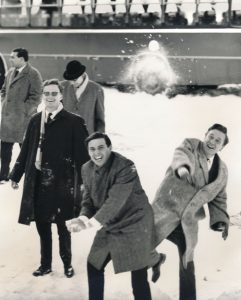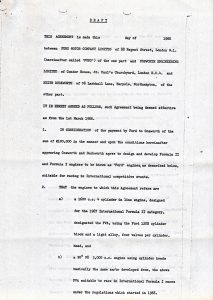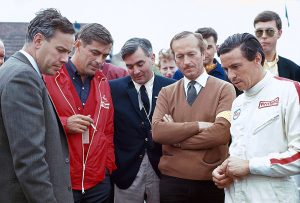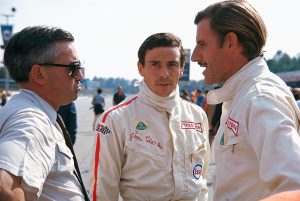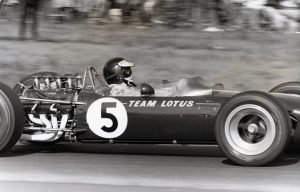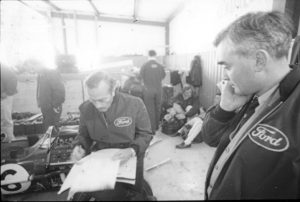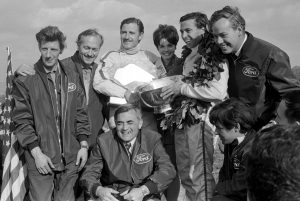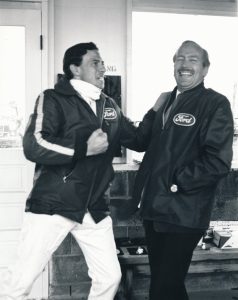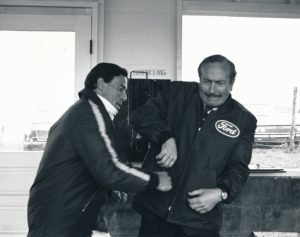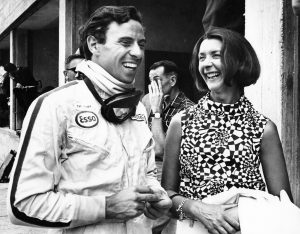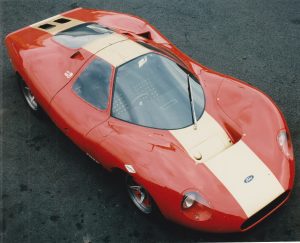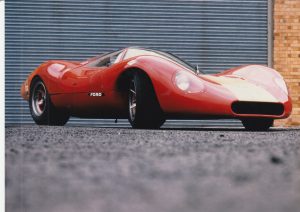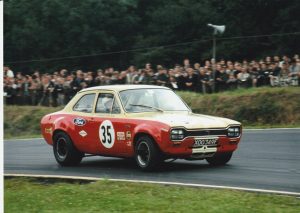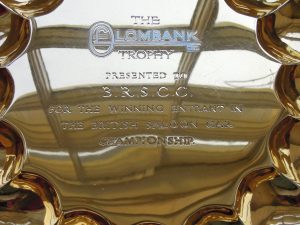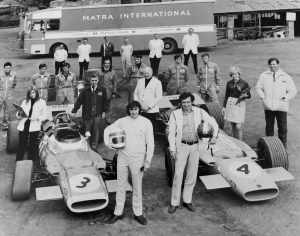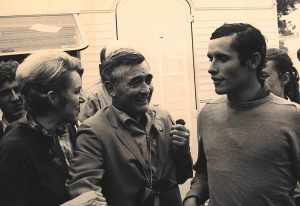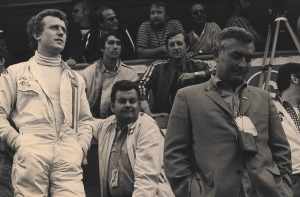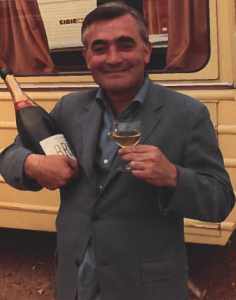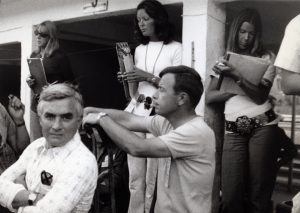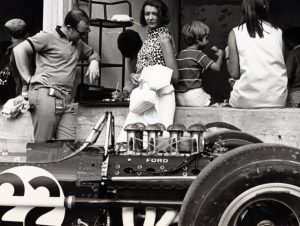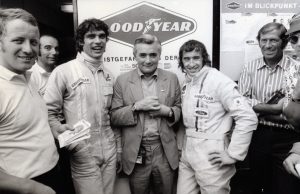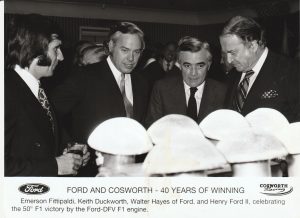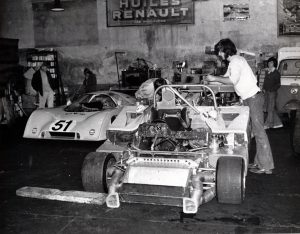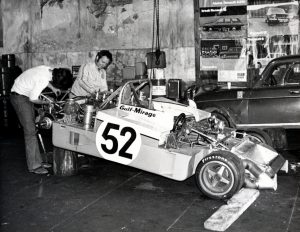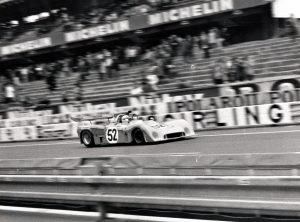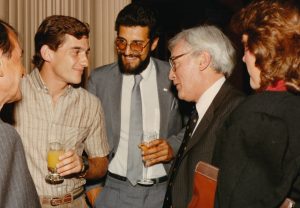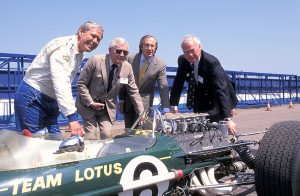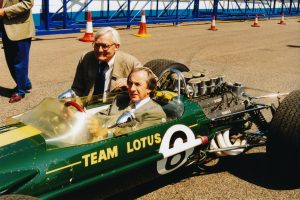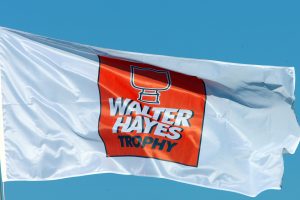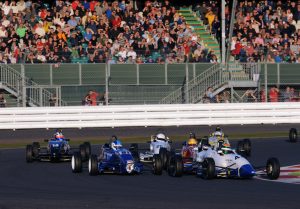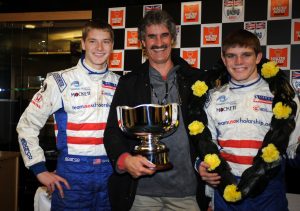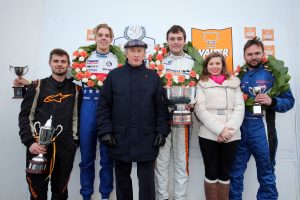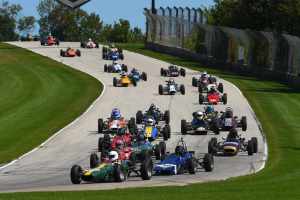Early days in the Lotus Ford partnership. Walter Hayes, Colin Chapman and the Lotus Ford Twin Cam 1600cc engine.
The 1963 celebrations in Cortina d’Ampezzo, to mark 200 wins for the Cortina and Lotus Cortina, included Jim Clark driving Walter Hayes down the bobsled run.
A moment of great significance in F1 history. During the same weekend in Cortina d’Ampezzo, Jim Clark prepares to throw a snowball at Walter Hayes; as he did so he pulled a muscle in his back, and was unable to race in the 1964 Rand Grand Prix the following month. 1964 was the season in which Sir Jackie Stewart was to make his F1 debut, driving for BRM, but Walter Hayes persuaded Tony Rudd of BRM to agree that Jackie could drive for Lotus in the first, and non-championship, event of the season. photo: Walter Hayes (See the article ‘The car and the man who saved the marque’ elsewhere in the archive).
A March 1966 draft of the contract between Ford and Cosworth to create the DFV Formula 1 and FVA Formula 2 engines. The agreement was double-spaced on foolscap paper, and ran to just five pages and three lines.
Keith Duckworth, Walter Hayes, Colin Chapman and Jim Clark all contemplate the unraced Ford Cosworth DFV, before the start of the Dutch GP, 1967. photo courtesy of and copyright Rainer Schlegelmilch. http://schlegelmilch.com
Walter Hayes, Jim Clark and Graham Hill. Monza, 1967. photo courtesy of and copyright Rainer Schlegelmilch. http://schlegelmilch.com
Jim Clark in the Lotus 49.
The Lotus pits at the Watkins Glen US GP in 1967. Colin Chapman and Walter Hayes, with Graham Hill and Jim Clark in the background.
Jim Clark prepares to celebrate his victory by pouring champagne over Walter Hayes. Colin Chapman, Graham Hill and Keith Duckworth anticipate the moment. The US GP, Watkins Glen, 1967. photo courtesy and copyright of Sutton Images. http://sutton-images.com.
Jim Clark and Colin Chapman, the German Grand Prix at the Nurburgring, 1967. photos by Walter Hayes.
Jim Clark and Elizabeth Hayes, the German Grand Prix at the Nurburgring, 1967. photo by Walter Hayes.
Brands Hatch, April 7th 1968. Walter Hayes and Alan Mann standing between a Ford GT40 and the Ford P68. The previous June the CSI had changed its sportscar regulations, ruling that prototypes should have 3 litre engines. This created the opportunity for the Ford Cosworth DFV to compete in endurance racing.
In its third race, the Spa 1000km, the P68 started on pole, having set a time five seconds faster than Jacky Ickx in a Ford GT40.
Walter Hayes, Alan Mann and Bruce McLaren, the BOAC 500, Brands Hatch, April 7th, 1968.
The P68 was designed by Len Bailey, who was seconded to Alan Mann Racing. Alan Mann was regarded by Hayes as Ford’s “racing manager”. Five months after work on it began, the car made its debut at the April 7th, 1968 BOAC 500. Bruce McLaren qualified second fastest, and led the race after an hour. His teammate, Mike Spence, was lying second as the second hour approached when a broken driveshaft coupling caused its retirement.
In a January 1968 internal briefing to Ford, Walter Hayes wrote: “It is imperative that we should make it clear to all concerned that this is an experimental motor car and the 1968 season is a development season. The only way to develop racing cars is to race them. I do not want people to start shouting too loud about this car in the early stages, because we can honestly say that by the time the BOAC 500 comes along the car will make its own reputation if it is successful in racing and the best way to protect its reputation is to maintain this point of view and make it clear to everybody concerned that we are interested in motor sport – that we know it makes a major contribution to the Company in Engineering – and that we are going to keep going.”
Reduced budgets and further regulation changes brought the programme to an end in 1969.
The P68 was driven or raced by four F1 world champions and six other F1 competitors: Dickie Attwood, Sir Jack Brabham, Frank Gardner, Hubert Hahne, Denis Hulme, Chris Irwin, Bruce McLaren, Jochen Rindt, Mike Spence and John Surtees.
John Wyer wrote of the P68: “It made a considerable impression and obviously had great potential but was never properly developed. It was, I believe, a great opportunity missed.”
The Ford Escort twin cam, run by Alan Mann Racing, in which Frank Gardner won the 1968 BRSCC Touring Car championship, and the championship trophy.
1969 Tyrrell F1 team and sponsor photo, in the famous woodyard. Walter Hayes, Sir Jackie and Lady Helen Stewart, Jean-Pierre Beltoise, Ken and Norah Tyrrell.
Walter Hayes and Jacky Ickx before the start of Le Mans, 1969. Ickx shared the victorious Ford GT40 with Jackie Oliver, run by John Wyer (JW Automotive).
Walter Hayes and Jackie Oliver, during the race.
Celebrating the GT40’s fourth consecutive victory.
The Karussell at the Nurburgring 1971. photo by Walter Hayes.
Norah Tyrrell, Walter Hayes, Cristina de Caraman, Leo Mehl and Helen Stewart, the Nurburgring, 1971.
Eoin Young, Elizabeth Hayes, Damon Hill and the Ford Cosworth DFV, the Nurburgring, 1971.
The Ford Escort twin cam, run by Alan Mann Racing, in which Frank Gardner won the 1968 BRSCC Touring Car championship, and the championship trophy.
Sir Jackie Stewart joined the Tyrrell F1 team in 1968, and over the next 6 seasons the Ford Cosworth DFV powered him to 24 victories and 3 world drivers’ championships. Bernard Cahier, Francois Cevert, Walter Hayes and Jackie Stewart shortly after Jackie’s win at the Nurburgring, 1971.
Emerson Fittipaldi, Keith Duckworth, Walter Hayes and Henry Ford II in 1972, celebrating the 50th victory of the Ford Cosworth DFV F1 engine. photo courtesy of Ford Motor Company.
The Le Mans test weekend, April 1973. The Gulf Mirage team ran two cars (first photo) to evaluate and compare the Ford Cosworth DFV V8 (right) and the Weslake V12. John Wyer based his team, as he had since 1953, at the Hotel de France in La-Chartre-sur-Le-Loir. This garage/workshop was across the square from the hotel, and each day the DFV-engined M6 was driven the 25 miles to Le Mans on the public roads. photos courtesy and copyright of Richard Hayes.
Ayrton Senna and Walter Hayes at the Detroit Grand Prix in 1984. Hayes was instrumental in the streets of Detroit becoming a F1 track, having been asked by Bernie Ecclestone to help the negotiations by acting as an intermediary.
Dick Scammell, Walter Hayes, Sir Jackie Stewart and Keith Duckworth celebrate the 30th anniversary of the Ford Cosworth DFV in 1997. photo courtesy of and copyright Rainer Schlegelmilch. http://schlegelmilch.com
Walter Hayes and Colin Chapman failed in 1966 to persuade Sir Jackie Stewart to drive for Lotus. 30 years later Stewart finally sat in a Lotus 49.
In a letter to Alan Mann written on January 5th, 1965, Hayes expressed his strong desire to have Sir Jackie Stewart race for Ford, and his conviction that Stewart was a F1 world champion in the making:
“I am quite sure that Stewart is going to be world champion one day. Although the two Lotuses were very much faster than anything else in South Africa (at one stage Clark led Surtees by 40 seconds!) (and even Spence was lying second for a long time having passed Surtees and Hill easily) Stewart with a much slower car and in his first Formula One event finished a very creditable sixth overall.”
The first Walter Hayes Trophy was a single race, held on August 26th, 2001, as part of the Silverstone Historic Festival. Sir Jackie Stewart, then President of the BRDC, decided that it should become an event in its own right, and under the direction of James Beckett it did so, just over two months later. Since then it has developed into the number one Formula Ford festival in the world, attracting between 120 and 150 drivers competing for what has become a prestigious trophy. photo courtesy and copyright of Jakob Ebrey. http://jakobebrey.com
Brooklands, Silverstone, 2015. photo courtesy and copyright of Jeff Bloxham. http://jeffbloxham.com
Team USA Scholarship has a history of bringing competitive drivers to the Walter Hayes Trophy, winning it three times. In 2008 its principal, Jeremy Shaw, brought Josef Newgarden and the victorious Conor Daly, both of whom are now Indycar drivers. http://teamusascholarship.org. photo courtesy and copyright of Jeff Bloxham. http://jeffbloxham.com
The 2016 podium. Fifteen years after making the Walter Hayes Trophy an annual event, Sir Jackie Stewart continues to support it. Tom McArthur, Oliver Askew, Sir Jackie Stewart, Niall Murray, Elizabeth Hayes, Josh Fisher. photo courtesy and copyright of Jakob Ebrey. http://jakobebrey.com
The Formula Ford 50th anniversary celebration at Road America, September 11-15, 2019, included the “Walter Hayes Vintage FF” race.
The top three were separated by just 0.4 seconds, and 2.4 seconds separated 8th to 16th – typical of the very close racing the Walter Hayes Trophy (WHT) is known for, and Formula Ford in general. Hence its enduring popularity.
The event was organised by Steve Beeler. https://www.stevebeeler.com/ features images, videos and extensive media coverage and background.
Photo courtesy and copyright of Jay Bonvouloir. albums


